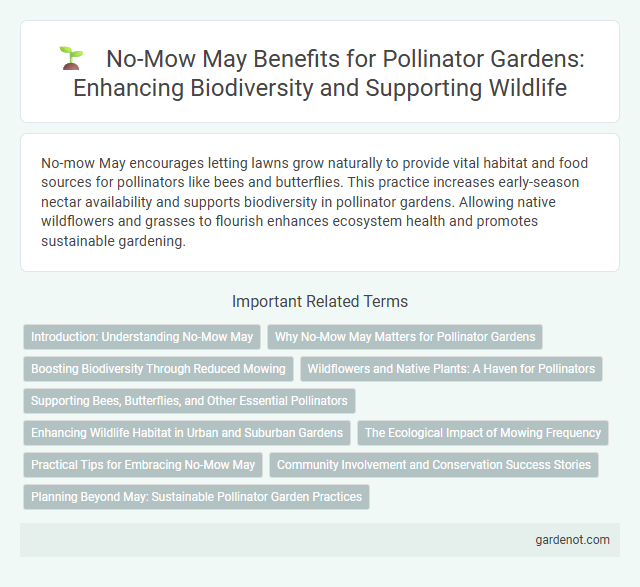No-mow May encourages letting lawns grow naturally to provide vital habitat and food sources for pollinators like bees and butterflies. This practice increases early-season nectar availability and supports biodiversity in pollinator gardens. Allowing native wildflowers and grasses to flourish enhances ecosystem health and promotes sustainable gardening.
Introduction: Understanding No-Mow May
No-Mow May is a conservation initiative encouraging homeowners to avoid mowing their lawns throughout May to support pollinator habitats. Allowing wildflowers and native plants to bloom naturally provides essential nectar and pollen sources for bees, butterflies, and other pollinators. This practice enhances biodiversity, improves soil health, and contributes to the sustainability of local ecosystems.
Why No-Mow May Matters for Pollinator Gardens
No-Mow May supports pollinator gardens by allowing native wildflowers and grasses to bloom, providing essential nectar and pollen sources for bees, butterflies, and other pollinators during early spring. Reducing lawn mowing preserves habitat structure, increasing biodiversity and improving pollinator health by offering refuge from predators and harsh weather. Implementing No-Mow May promotes ecological balance and strengthens the resilience of pollinator populations critical for ecosystem services and crop pollination.
Boosting Biodiversity Through Reduced Mowing
No-mow May significantly enhances pollinator garden biodiversity by allowing native plants and wildflowers to flourish, providing essential habitats and food sources for bees, butterflies, and other pollinators. Reduced mowing promotes soil health and increases the abundance of nectar-rich plants vital for sustaining diverse pollinator populations. This simple ecological practice supports ecosystem resilience and contributes to the conservation of declining pollinator species.
Wildflowers and Native Plants: A Haven for Pollinators
Wildflowers and native plants flourish during No-mow May, creating vital habitats that support a diverse range of pollinators such as bees, butterflies, and hummingbirds. These plant species provide essential nectar and pollen sources while enhancing biodiversity and soil health. Allowing lawns to grow naturally without mowing fosters a resilient ecosystem critical for pollinator survival and reproduction.
Supporting Bees, Butterflies, and Other Essential Pollinators
No-mow May enhances habitat quality by allowing native wildflowers and grasses to bloom, providing vital nectar and pollen sources for bees, butterflies, and other essential pollinators. This practice reduces habitat disturbance, promoting healthier pollinator populations that support biodiversity and improve pollination services for surrounding crops and plants. By minimizing mowing, ecosystems benefit from increased floral diversity and extended foraging opportunities critical to pollinator survival.
Enhancing Wildlife Habitat in Urban and Suburban Gardens
No-mow May boosts pollinator populations by allowing native wildflowers and grasses to bloom, creating vital habitats in urban and suburban gardens. This practice supports bees, butterflies, and other beneficial insects, increasing biodiversity and improving ecosystem services such as pollination and soil health. Integrating no-mow zones enhances wildlife corridors and promotes sustainable green spaces within city landscapes.
The Ecological Impact of Mowing Frequency
Reducing mowing frequency during No-mow May significantly enhances pollinator habitats by allowing wildflowers to bloom and provide essential nectar and pollen sources. This practice supports biodiversity by promoting the growth of native plants and increasing insect populations, including bees and butterflies. Lower mowing frequency also improves soil health and carbon sequestration, contributing to a more sustainable urban ecosystem.
Practical Tips for Embracing No-Mow May
Allow grass to grow naturally during No-Mow May to create essential habitats for pollinators like bees and butterflies. Use selective mowing techniques around flower clusters to protect native plants while maintaining yard aesthetics. Incorporate native wildflowers and avoid pesticides to enhance biodiversity and support a thriving pollinator garden.
Community Involvement and Conservation Success Stories
No-mow May initiatives engage communities by encouraging residents to halt lawn mowing, fostering habitats for pollinators like bees, butterflies, and native birds. Neighborhoods and local organizations report increased biodiversity and flourishing pollinator populations, contributing to local ecosystem restoration. Conservation success stories highlight collaborative efforts where no-mow campaigns resulted in measurable boosts in pollinator diversity and educational outreach promoting sustainable gardening practices.
Planning Beyond May: Sustainable Pollinator Garden Practices
No-mow May initiates a vital shift towards creating sustainable pollinator gardens by promoting reduced lawn mowing to support native wildflowers and beneficial insects. Strategic planning beyond May includes integrating diverse, native plant species, maintaining continuous bloom cycles, and minimizing chemical use to enhance habitat diversity and pollinator health year-round. Establishing layered plant structures and incorporating water sources further sustain pollinator populations and ecosystem resilience.
No-mow May Infographic

 gardenot.com
gardenot.com